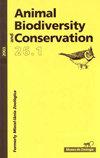Density and activity patterns of bobcat in its southernmost distribution
IF 1
4区 环境科学与生态学
Q3 BIODIVERSITY CONSERVATION
引用次数: 2
Abstract
Estimating density and activity patterns is useful for management and conservation of species. Data for Mexican bobcat (Lynx rufus) populations are scarce. Here we estimated the density of a bobcat population in Oaxaca, southern Mexico, and evaluated its daily activity patterns. We also evaluated macroecological patterns of bobcat density across its distribution range to determine any geographical (latitudinal, longitudinal, elevation, or range centroid) or climatic effects on the population density. Camera–trap data were divided into four 60–day periods (two in the dry season and two in the rainy season). Density was calculated using the random encounter model and daily activity patterns were analyzed fitting a kernel density function. The mean estimated density for the four periods was 17.3 bobcats/100 km2, with the highest densities occurring during the dry periods. Bobcat daily activity pattern presented two peaks, one after midnight and the other after dawn, with very slight changes between seasons. In the study area, density and activity patterns were associated with anthropogenic perturbation and prey availability. Bobcats increased their population density in the dry season, and showed a preference for activity at night and early morning hours when it is cooler and there are likely fewer competitors but more prey. Across its range, bobcat density was mainly related to annual precipitation and mean temperature of the driest quarter at 100 km radius buffers, and between annual precipitation and longitude on a smaller scale (50 km radius buffers). These findings support their preference for the arid or mesic environments that enabled them to reach southern areas of the Neartic region.山猫最南端分布的密度和活动模式
估计密度和活动模式对物种的管理和保护是有用的。关于墨西哥山猫(Lynx rufus)种群的数据很少。在这里,我们估计了墨西哥南部瓦哈卡州山猫种群的密度,并评估了它的日常活动模式。我们还评估了山猫密度在其分布范围内的宏观生态模式,以确定地理(纬度、纵向、海拔或范围质心)或气候对人口密度的影响。捕集器数据被分为4个60天周期(两个旱季和两个雨季)。采用随机相遇模型计算密度,拟合核密度函数分析日常活动模式。4个时期山猫平均密度为17.3只/100 km2,干旱期密度最高。山猫日活动模式呈现午夜后和黎明后两个高峰,季节间变化不大。在研究区,密度和活动模式与人为扰动和猎物可得性有关。山猫在旱季增加了它们的人口密度,并表现出偏好在夜间和清晨活动,因为这两个时间比较凉爽,竞争对手可能较少,但猎物更多。在其范围内,山猫密度主要与100 km半径范围内最干燥季的年降水量和平均气温有关,在较小范围内(50 km半径范围内)与年降水量和经度有关。这些发现支持了它们对干旱或湿润环境的偏好,使它们能够到达邻近地区的南部地区。
本文章由计算机程序翻译,如有差异,请以英文原文为准。
求助全文
约1分钟内获得全文
求助全文
来源期刊

Animal Biodiversity and Conservation
农林科学-动物学
CiteScore
2.00
自引率
0.00%
发文量
21
审稿时长
>12 weeks
期刊介绍:
Animal Biodiversity and Conservation (antes Miscel·lània Zoològica) es una revista interdisciplinar, publicada desde 1958 por el Museu de Ciències Naturals de Barcelona. Incluye artículos de investigación empírica y teórica en todas las áreas de la zoología (sistemática, taxonomía, morfología, biogeografía, ecología, etología, fisiología y genética) procedentes de todas las regiones del mundo. La revista presta especial interés a los estudios que planteen un problema nuevo o introduzcan un tema nuevo, con hipòtesis y prediccions claras, y a los trabajos que de una manera u otra tengan relevancia en la biología de la conservación. No se publicaran artículos puramente descriptivos, o artículos faunísticos o corológicos en los que se describa la distribución en el espacio o en el tiempo de los organismes zoológicos.
 求助内容:
求助内容: 应助结果提醒方式:
应助结果提醒方式:


